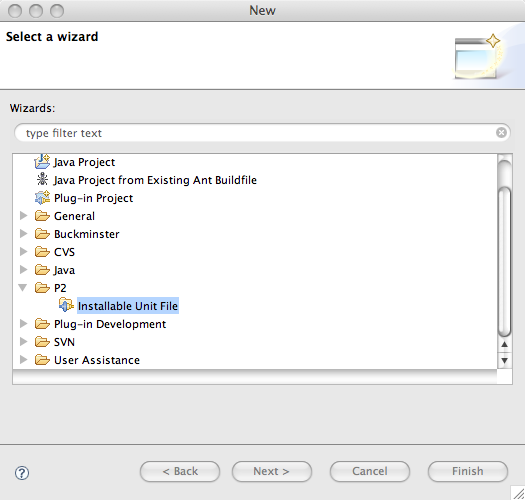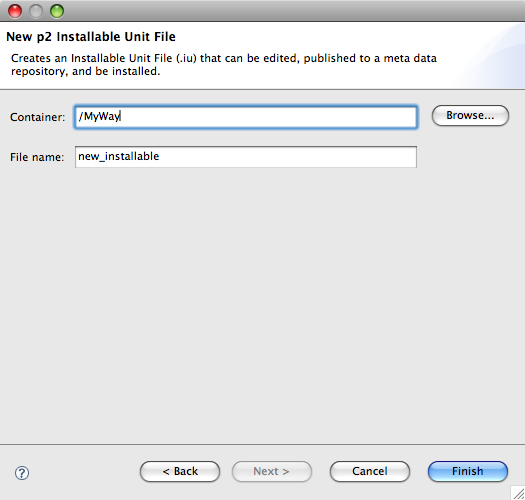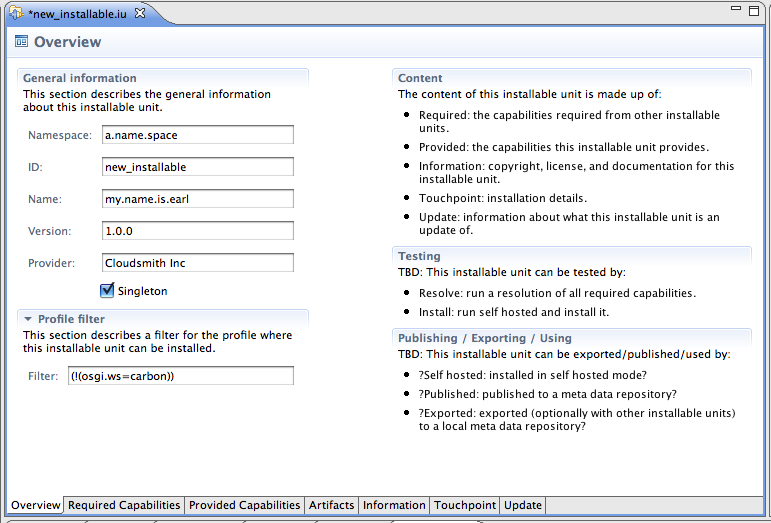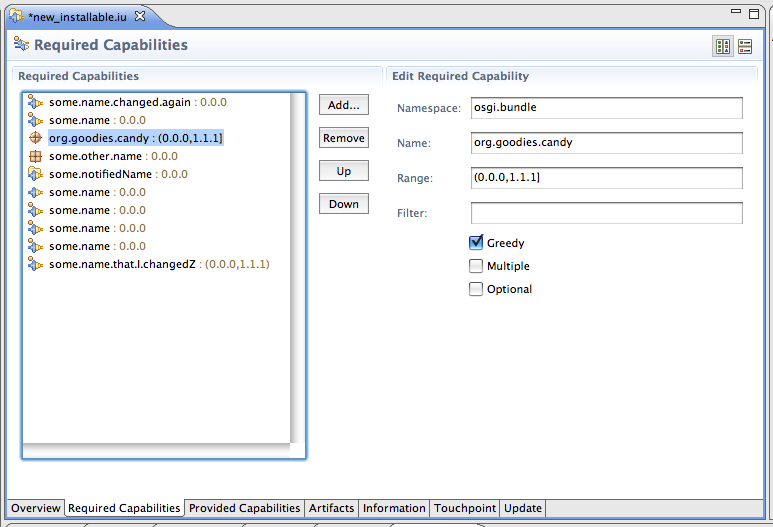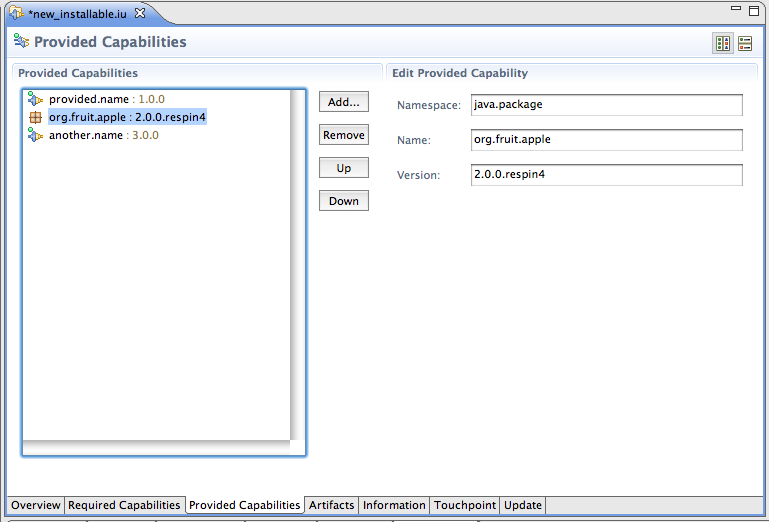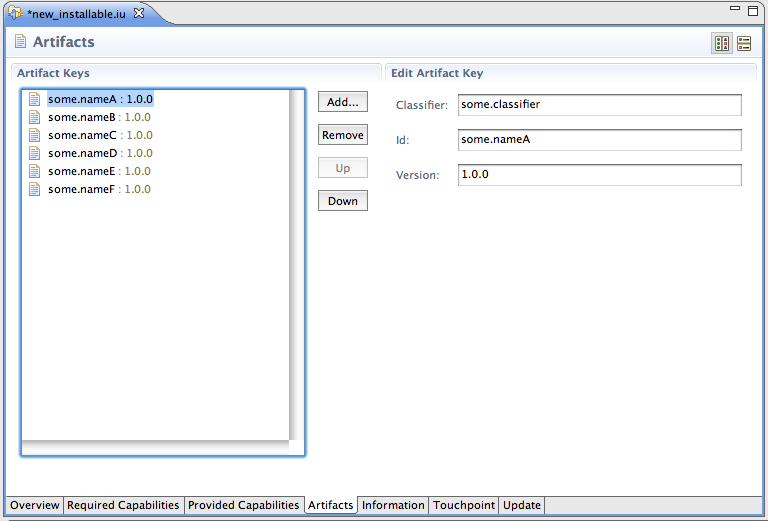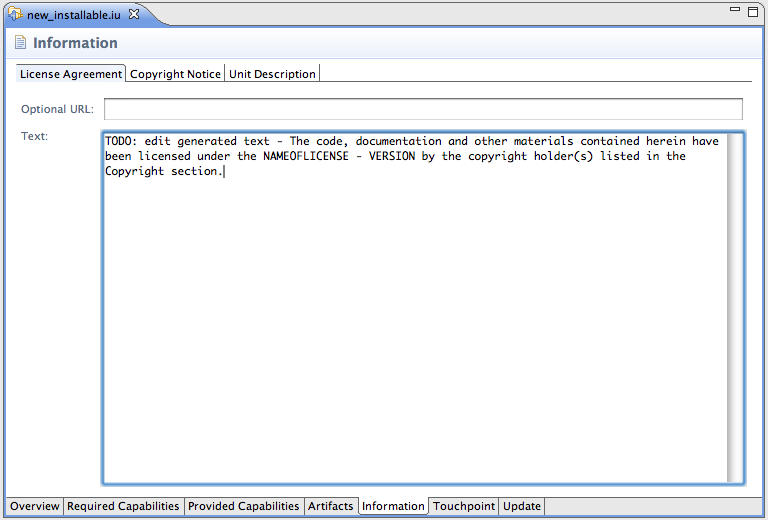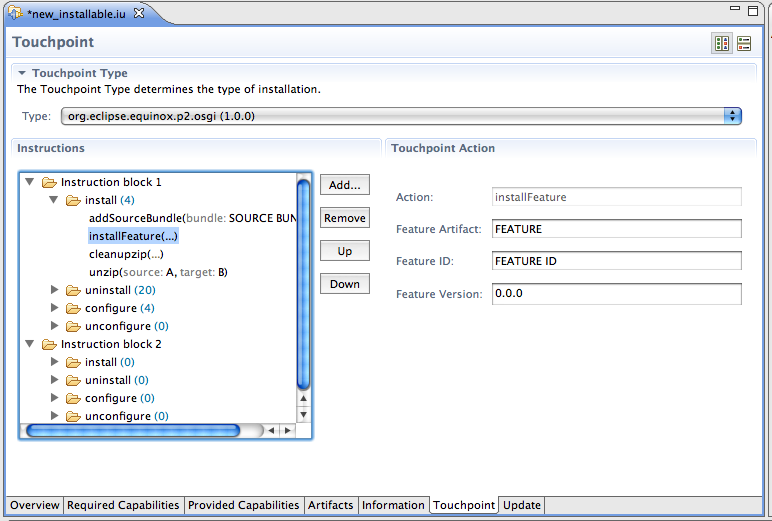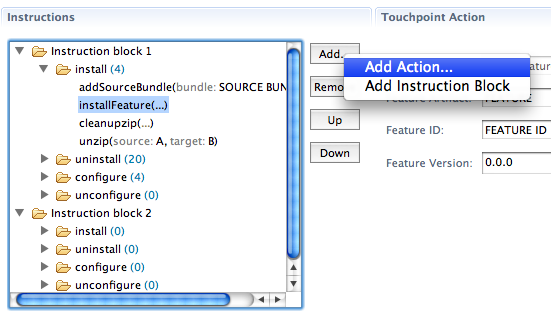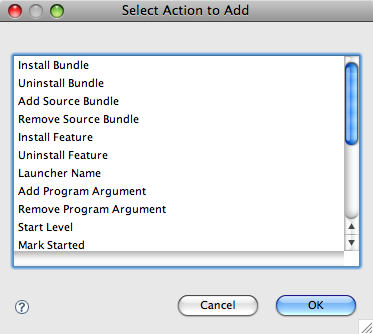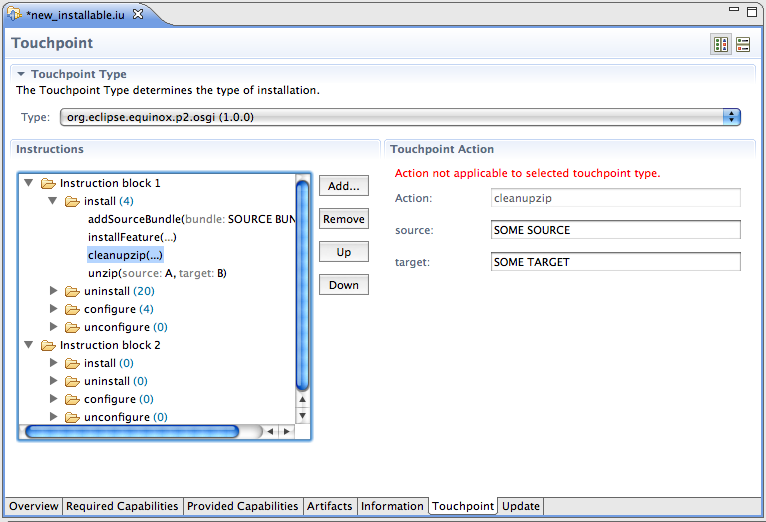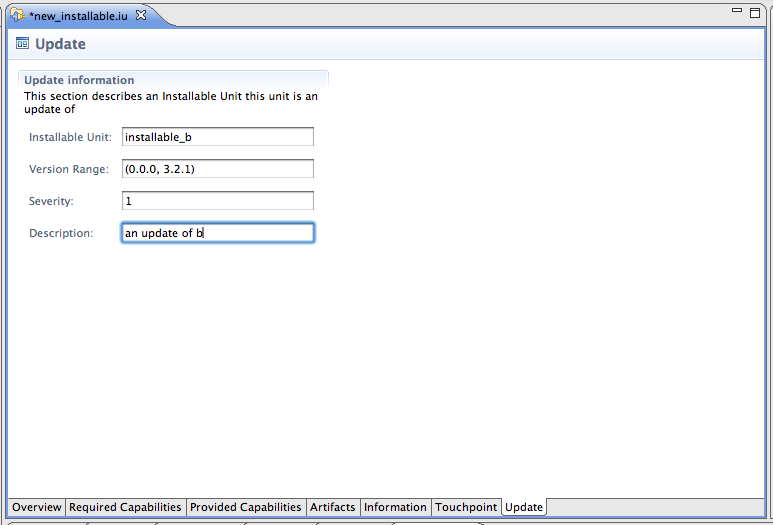Notice: This Wiki is now read only and edits are no longer possible. Please see: https://gitlab.eclipse.org/eclipsefdn/helpdesk/-/wikis/Wiki-shutdown-plan for the plan.
Equinox p2 Metadata Authoring
This page describes the design of the proposed p2 meta data authoring project.
Contents
Metadata authoring proposal
The problems this project should solve:
- Many types are automatically "adapted" to installable units (e.g. features and plugins), but there is no direct authoring available.
- Existing "adapted" installable units may have meta data that needs to be modified/augmented in order for the unit to be useful - there is a mechanism available to provide advice to the resolution mechanism, but authoring of such advice is not.
I think the work consists of:
- An XML definition for "authored installable unit" (most likely the <unit> format in the local meta data repository). It should be possible to create such an "iu" file with any name without requirements that it is in some special project or folder.
- An XML definition for "advice to adapted installable unit" (as I am not sure what is needed here, a separate definition is perhaps needed).
- An editor for Installable Unit
- Ad editor for Installable Unit advice (is perhaps the same editor).
- A way to test the installable unit (resolution, install-ability)
- A way to export/publish installable units
Files and Formats
A new Installable Unit file can be created with the New IU Wizard.
It is possible to browse for the container, and then create the file:
The format of the "IU" file
It seems obvious to reuse the xml format from the local meta data repository as it already describes an installable unit.
<?xml version='1.0' encoding='UTF-8'?>
<?InstallableUnit class='org.eclipse.equinox.internal.p2.metadata.InstallableUnit' version='1.0.0'?>
<installable version="1.0.0">
<unit>
<!-- like local metadata repository for 'unit' element -->
</unit>
</installable>
In order to make it easier to reuse the parser/writer for the local metadata repository, a new root element "<installable>" is used to wrap a single "<unit>" element. This also opens up the possibility to include other elements (than unit) if required.
Naming convention
To make it easy to detect the "IU" files an ".iu" extension should be required.
Writer/Parser design
It was possible to crete a prototype that read and writes this format by reusing the metadata repository XMLReader and XMLWriter. It is however a bit unclear if the intention is to allow the InstallableUnit to be used by an editor, or if these classes should be considered internal/private.
The IU Editor
The IU editor is written with PDE Forms. The editor has support for:
- Validation of (most) fields with interactive error reporting
- Undo/Redo support that also moves focus to the modified page/field
Overview Page
Namespace
The namespace is the naming scope of the installable unit's name. From what has been understood by looking at some installable, these are examples of namespaces:
- org.eclipse.equinox.p2.iu
- org.eclipse.equinox.p2.eclipse.type
- osgi.bundle
- java.package
- org.eclipse.equinox.p2.localization
Namespace Questions
- Should the user be allowed to type anything in the namespace field?
- If not allowed to type anything - where are the valid namespaces found?
- Can the set of namespaces be extended?
- Does namespace have a valid format (looks like it follows package name format)?
- Can namespace be left empty?
- There are two namespace properties - one called namespace_flavor, and one namespace_IU_ID - is there a description of how these are used?
Namespace Implementation
- Namespace is required
- The namespace field is validated as a structured name (i.e. like a java package name)
ID
ID Questions
- What is ID - how is it different from name?
- What is the valid format?
- What determines the format - can it be different in different name spaces?
ID Implementation
- ID Is required
- Any string input is accepted
Name
Name Questions
- What is the valid format of a name?
- Is format determined by p2 for all namespaces, or can name format vary between different namespaces?
- If it can vary, how is the namespace/name validation extended to new namespaces?
Name Implementation
The assumption is that the name should follow structured java naming - i.e. a pattern that:
- name can consist of multiple parts where parts are separated by a "."
- each part must be at least one char long
- each part must begin with a-zA-Z_$
- subsequent chars in a part can be a-zA-Z0-9_$
Version
Version Implementation
- Version is an OSGi version and is validated as one.
- Version is required.
Provider
Provider is an optional information about the provider (name of organization or individual) providing the unit.
Provider Implementation
- Optional string value. No validation.
Filter
This is assumed to be an LDAP filter expression.
Filter Questions
- Is the assumption correct (LDAP filter expression)?
- Is it meaningful to provide structured input of the filter (i.e. like feature editor with separate sections for platform, arch, window system, arch and language)?
- is p2 open and can filter on an expandable set of variables, or is it a fixed set (platform, arch, window system, arch and language)?
Filter Implementation
- The field uses a LDAP filter validator that conforms to the RFC 2254 for textual representation of LDAP filter with the following exceptions:
- OCTAL STRING input is not handled
- attribute options (e.g.";binary") is not handled
- use of extensions or reference to LDAP matching rules is not handled
- (currently) the attribute names are restricted to US ASCII letters, digits and the hyphen '-' character and '.' to separate parts in a structured name. (RFC 2254 specifies that ISO 10646 should be used, and that "letters", "digits" and "hyphens" are allowed.)
Required Capabilities
A list of required capabilities is shown and the user can add/remove, and move items up/down. Selecting an item opens the detail editor. Icons are set based on namespace. There is currently no repository lookup.
Provided Capabilities
This is implemented in the prototype by showing a list of provided capabilities. Entries can be added/removed, and moved up/down and edited.
Artifact Keys
Artifact keys can be added/removed, and moved up/down and edited. There is currently no repository lookup.
Artifact Questions
- What is "Classifier" - can this be a drop down list?
- What determines what the classifier can be?
- What determines its format? - it is now validated as a structured name
Information
The editor has editing of the information copyright notice, license agreement, and description. Some boilerplate text is inserted as a starting point.
Touchpoint Page
An installable Unit can be installed into one touchpoint. The IU meta data consists of a reference to the touchpoint (Touchpoint Type), and describes a set of actions/instructions to execute on the referenced touchpoint. Currently, two touchpoint types (native, and eclipse/osgi) have been implemented. The native touchpoint has aprox 5 different actions, and the eclipse touchpoint has aprox 20. Some of these actions take parameters.
Here is a list of the actions per touchpoint
The editor allows blocks of instructions to be added (touchpoint data), and each such instruction block allows editing of actions per instruction (aka. phase). There is meta data that describes the touchpoints available (native 1.0.0, and eclipse 1.0.0) which makes it possible to show better labels, list available actions etc.
Instructions and actions are added by pressing add, and selcting in the popup menu that appears:
The available actions are displayed, and user can select the action to add.
If the user switches between touchpoint types - I decided to keep actions previously added (the alternative would be to remove actions that does not apply). Instead a message is displayed above the area for editing the action. (I really wanted to use the same error reporting as used elsewhere, but ran into a design flaw that made it difficult to keep this paricular type of problem in sync).
Handling of Unknown Touchpoint Type
The editor handles an IU file with an unknown touchpoint type by allowing editing of existing actions, but not adding new. Actions for an unknown touchpoint type are shown with the parameter names instead of formatted labels. When the original IU has an unknown type, that type is selectable in the type box (this to support a user trying to change the touchpoint type to something else and realizing that it is best to stick with the original). If the file is saved with a known touchpoint type, it is not possible to get the unknown type back again without editing the XML directly.
Touchpoint Questions
- Do you think it is ok to keep actions and instructions when switching touchpoint type even if they do not apply, and let the user delete them, or should all non applicable instructions and actions be removed (undoable))?
Touchpoint Notes
- p2 has a bug (link to issue TBD) that merges multiple instrucion blocks into one when reading the meta data. (The editor is not to blame if you run into this problem)
- There is an enhancment request logged (link to issue TBD) - for being able to save the name of an instruction block (aka TouchpointData). The editor assigns labels called "Instruction block n" where n is the block number.
- There is an issue with parameter values containing "," that causes p2 meta data to go off track. The editor therefore filters out all "," characters from parameter value fields for actions.
- There is no validation of input fields for actions - this is somewhat difficult as runtime substitution of "${variable}" is supported.
- Actions can be moved up/down within an instruction.
- Instructions can not be moved - the editor displays all phases/instructions (empty instructions are not written to XML)
- Instruction blocks can be moved up/down
Update
The editor has an "Update" page where information about what IU's the specified IU is an update of.
Update Questions
- What is the valid values for severity?
Update Implementation
- The severity can now be set to a value >= 0
- The description field should probably be longer.
TODO
- lookup of required capabilities from meta data repositories
- lookup of artifacts from artifact repository
- lookup of things from workspace
- handle persistent problem markers (at least managed by the editor)
- "test/build/install"
- handle fragment
- handle patch
- Are there additional properties that should be editable (lock? contact email?)

